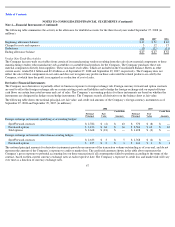Apple 2008 Annual Report Download - page 71
Download and view the complete annual report
Please find page 71 of the 2008 Apple annual report below. You can navigate through the pages in the report by either clicking on the pages listed below, or by using the keyword search tool below to find specific information within the annual report.
Table of Contents
NOTES TO CONSOLIDATED FINANCIAL STATEMENTS (Continued)
Note 2—Financial Instruments (Continued)
The estimates of fair value are based on applicable and commonly used pricing models and prevailing financial market information as of
September 27, 2008 and September 29, 2007. Although the table above reflects the notional principal, fair value, and credit risk amounts of the
Company’s foreign exchange instruments, it does not reflect the gains or losses associated with the exposures and transactions that the foreign
exchange instruments are intended to hedge. The amounts ultimately realized upon settlement of these financial instruments, together with the
gains and losses on the underlying exposures, will depend on actual market conditions during the remaining life of the instruments.
Foreign Exchange Risk Management
The Company may enter into foreign currency forward and option contracts with financial institutions to protect against foreign exchange risk
associated with existing assets and liabilities, certain firmly committed transactions, forecasted future cash flows, and net investments in foreign
subsidiaries. Generally, the Company’s practice is to hedge some portion of its material foreign exchange exposures. However, the Company
may choose not to hedge certain foreign exchange exposures for a variety of reasons, including but not limited to, immateriality, prohibitive
economic cost of hedging particular exposures, or limited availability of appropriate hedging instruments.
To help protect gross margins from fluctuations in foreign currency exchange rates, certain of the Company’s U.S. dollar functional subsidiaries
hedge a portion of forecasted foreign currency revenue, and the Company’s non-U.S. dollar functional subsidiaries selling in local currencies
hedge a portion of forecasted inventory purchases not denominated in the subsidiaries’ functional currency. Other comprehensive income
associated with hedges of foreign currency revenue is recognized as a component of net sales in the same period as the related sales are
recognized, and other comprehensive income related to inventory purchases is recognized as a component of cost of sales in the same period as
the related costs are recognized. Typically, the Company hedges portions of its forecasted foreign currency exposure associated with revenue and
inventory purchases for three to six months.
Derivative instruments designated as cash flow hedges must be de-designated as hedges when it is probable the forecasted hedged transaction
will not occur in the initially identified time period or within a subsequent 2 month time period. Deferred gains and losses in other
comprehensive income associated with such derivative instruments are immediately reclassified into earnings in other income and expense. Any
subsequent changes in fair value of such derivative instruments are also reflected in current earnings unless they are re-designated as hedges of
other transactions. The Company has not recognized any material net gains during 2008, 2007 and 2006, related to the loss of a hedge
designation on discontinued cash flow hedges. As of September 27, 2008, the Company had a net deferred gain associated with cash flow hedges
of approximately $19 million, net of taxes, substantially all of which is expected to be reclassified to earnings by the end of the second quarter of
fiscal 2009.
The net gain or loss on the effective portion of a derivative instrument designated as a net investment hedge is included in the cumulative
translation adjustment account of accumulated other comprehensive income within shareholders’ equity. For the years ended September 27,
2008 and September 29, 2007, the Company had a net loss on net investment hedges of $12.2 million and $2.6 million, respectively, included in
the cumulative translation adjustment.
The Company may also enter into foreign currency forward and option contracts to offset the foreign exchange gains and losses generated by the
re-measurement of certain assets and liabilities recorded in non-functional currencies. Changes in the fair value of these derivatives are
recognized in current earnings in other income and expense as offsets to the changes in the fair value of the related assets or liabilities. Due to
currency market movements, changes in option time value can lead to increased volatility in other income and expense.
68
























